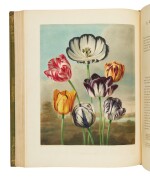The John Golden Library: Book Illustration in the Age of Scientific Discovery
The John Golden Library: Book Illustration in the Age of Scientific Discovery

Thornton, Robert John | The Age of Romanticism fully blooms
Auction Closed
November 22, 05:54 PM GMT
Estimate
150,000 - 200,000 USD
Lot Details
Description
Thornton, Robert John
New Illustrations of the Sexual System of Carolus Von Linnaeus … The Temple of Flora, or Garden of Nature. London: for the Publisher, by T.Bensley [1799-] 1807-[1812]
Folio (575 x 460mm). 31 finely colored aquatint, mezzotint and etched botanical plates sumptuously depicting flowers and 5 colored portraits of: Linnaeus, "Linnaeus in his Lapland Dress," "Flora dispensing Her Favours on the Earth," "Aescapulius, Flora, Ceres and Cupid honouring the Bust of Linnaeus" and "Cupid inspiring Plants with Love" and with 12 engraved calligraphic titles, half-titles, dedications, contents leaves, etc., 6 engraved plates and tables, 9 uncolored engraved portraits of Thornton, Linnaeus, Queen Charlotte, etc.; but for some offsetting most noticeably to text, the colors fresh and vibrant. Contemporary English light green straight-grained morocco, ornately gilt, plum endpapers; scuffing, wear to edges.
The magnificent Doheny Copy of the greatest English Flower Book and a defining work of the period.
One of the grandest and most sumptuous of English botanical books, couched in the Romantic idiom. A lovely copy apparently bound from the original parts, with first or early issues of many of the plates and one in proof state.
Conceived on a grandiose scale, New Illustration was to comprise three parts: a dissertation on the sexual reproductive cycle of plants; an explanation of Linnæus's plant system, lavishly illustrated with botanical plates and portraits of botanists; and "The Temple of Flora," which was to have no less than 70 large plates of exotic plant species arranged according to the classification system of Linnæus. Each species was to appear in its native environment.
The production of the plates for "The Temple of Flora" involved a variety of techniques—aquatint, mezzotint, stipple engraving, and stippling with line engraving, or etching, which required the participation of a large number of artists. Among those commissioned by Thornton were Philip Reinagle, who executed most of the preparatory drawings; Abraham Pether, known for his moody quasi-Gothic landscapes; Sydenham Edwards and Peter Henderson; and the engravers Richard Earlom, James Caldwall, and Thomas Burke. Only the plate of the Rose was drawn by Thornton and executed by Earlom.
In spite of using a host of artists and engravers, Thornton managed to "maintain a remarkable homogeneity of style throughout" (Oak Spring Flora), but production was a protracted stop-and-go affair, causing the text and plates to appear irregularly, and to bring Thornton ultimately to the brink of personal bankruptcy.
For his contribution to English botanical illustration, Thornton has been compared to Redouté by Alan Thomas: "[M]ore or less coeval with Redouté in France came the production of the greatest English colour-plate flower book. … What Redouté produced under the patronage of L'Héritier, Marie Antionette, the Empress Josephine, Charles X and the Duchesse de Berry, Thornton set out to do alone. … The result was almost total failure. … His fortune was engulfed and his family reduced to penury. … It is easy to raise one's eyebrows at Thornton's unworldly and injudicious approach to publishing … but he produced … the most strikingly beautiful set of flower plates ever to be printed in England [and] one of the loveliest books in the world" (Great Books and Book Collectors, pp. 142–144).
Yet, as its enduring appeal proves, Thornton's vision transcends the genre. That a book of botanical illustration could come to summarize the Age of Romanticism is a tribute to imaginative genius in aesthetic crossed with scientific inquiry. "To arrive at Thornton is to boil down all the diversities of the time in architecture, poetry, painting, fiction, music, from Walpole and Sir William Chambers to Shelley and the music of Weber, by way of Chatterton writing in Gothic or African mood of Medieval Bristol or reeking tigers, by way of the wild imaginings of Turner, or Martin or Francis Danby, by way of elements even in Blake, in Coleridge, in Wordsworth. An age is packed into these folio plates which Thornton directed" (Geoffrey Grigson in Thornton's Temple of Flora, p. 12).
REFERENCE:
Dunthorne 301; Grigson and Buchanan, Thornton's Temple of Flora (1951); Nissen 1955; Stafleu TL2 14.283.
PROVENANCE:
Estelle Doheny (leather book label; her sale Christie's New York, 21 February 1989, lot 2196)
